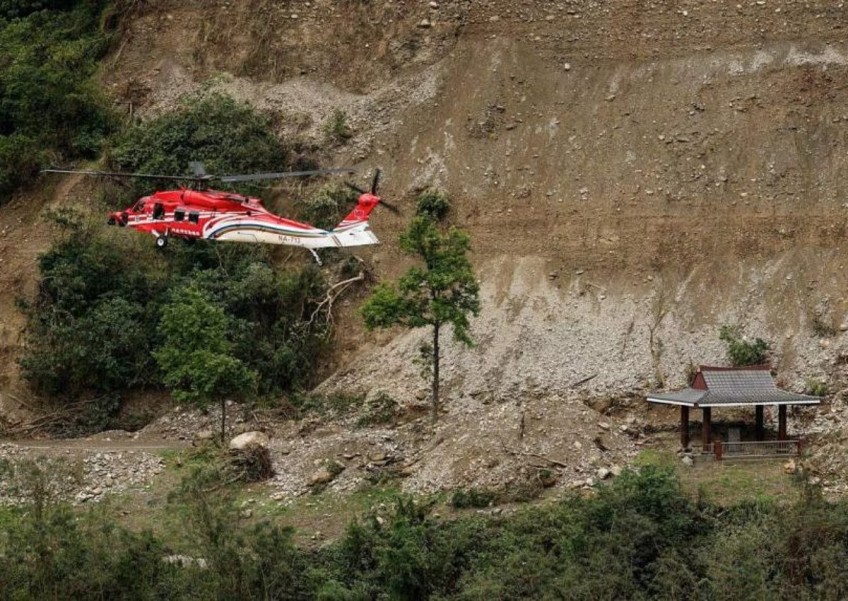'Not giving up': Taiwan rescuers race against time to save missing, stranded quake victims


HUALIEN, Taiwan – Rescue efforts are still under way to reach some 340 people who remain stranded in the mountains in rural Hualien county, three days after Taiwan’s strongest earthquake in 25 years toppled buildings and triggered landslides.
The authorities have said that all of those stranded are judged to be safe with access to food and water, though they were cut off after massive boulders damaged roads and blocked tunnels.
Meanwhile, rescuers are racing against time amid constant aftershocks and poor weather conditions to locate six missing people, including a Singaporean couple. The two have not been seen since disembarking from a tour bus in the county’s Taroko Gorge on the morning of the quake on April 3.
In a statement on April 6, Taiwan’s Immigration Agency said the authorities were in contact with the couple’s families.
The death toll from the 7.4-magnitude earthquake, which struck at around 8am in the waters off the eastern coastal county, rose to 13 after three bodies were found on a walking trail. More than 1,000 others were injured.
On April 6, helicopters from the National Airborne Service Corps flew into cut-off areas of the national park to airlift dozens of stranded tourists to safety.
They include those who had been staying at the luxury Silks Place Taroko hotel, located deep within Taroko Gorge.
“The subsequent aftershocks were very large and serious,” a pastor identified only as Mr Zhou told reporters upon arriving at the gorge’s rescue command centre after he was rescued. “I felt very nervous when I was sleeping.”
The centre was abuzz with activity when The Straits Times visited on April 6, with rescue workers from multiple counties setting up work stations and conducting initial health checks for evacuees. A bus unloaded 13 tourists of various nationalities, several smiling with relief. They declined to be interviewed.
Taiwan has been rattled by more than 600 aftershocks since the initial quake, some of which were strong enough to trigger phone alerts warning the public to stay calm and seek cover.
The aftershocks, on top of occasional fog and wet weather, have hindered rescue efforts, said Taiwan’s fire department, which was forced on April 6 to suspend plans to use heavy machinery to lift massive boulders in areas more susceptible to landslides.
However, rescuers managed to airdrop boxes of food and supplies to a group of pupils and teachers stuck at an elementary school that could not be accessed by road.
“Rescuers are not giving up,” said Taiwanese Vice-President-elect Hsiao Bi-khim, who called them the “true heroes of a resilient Taiwan”.
The relatively low number of deaths from such a powerful earthquake is attributed to lessons learnt from the 7.6-magnitude quake in 1999 that killed 2,400 people.
These include government mandates on stricter building codes, as well as widespread public disaster education on the earthquake-prone island.
“The news keeps reporting how other countries are impressed with our earthquake preparedness, but it’s just what we’ve been taught to do since we were young,” said Hualien resident Hsiao Yo-juan, noting that “everyone naturally takes cover” during a quake.
Most of the victims of the April 3 earthquake were killed outdoors by falling rocks or landslides while hiking or driving.
The death toll could have been much higher had the quake occurred just one day later, when many travellers would have been on the road to kick off a four-day long weekend for Children’s Day and the Qing Ming Festival, when families gather to honour the departed.
In central Hualien City, demolition work continued for the heavily tilting Uranus building, a 10-storey mix of shops and flats that has become one of the most recognisable images of the quake.
A resident, who wanted to be known only as Ms Lin, sobbed as she watched cranes claw through the brick walls of her former home.
“I knew there was no way to salvage the building, but it’s still heartbreaking to watch,” she told reporters. “But I’m not complaining. I’m very lucky to be alive.”
Just as fortunate are a Singaporean engineer and his girlfriend, who escaped barefoot from their shaking third-floor accommodation in Hualien City when the earthquake struck.
With the help of some locals, the couple managed to leave the city for Kaohsiung, where they secured a flight home to Singapore.
ALSO READ: 'Everyone run out!' Singaporean family of 6 flees eatery in Taiwan seconds before building crumbles
This article was first published in The Straits Times. Permission required for reproduction.